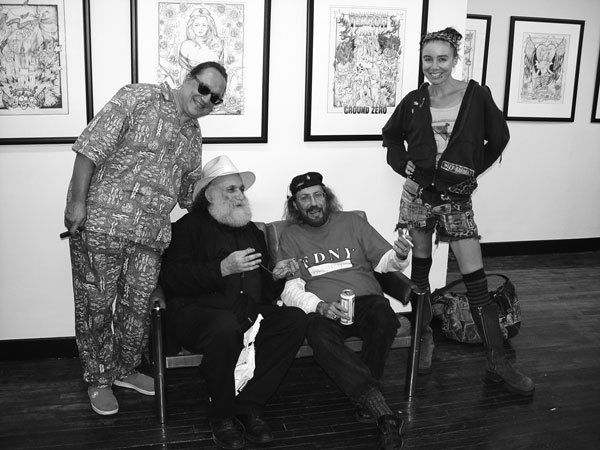 [/media-credit]
[/media-credit]
“Naked Eye Cinema”’s home base was ABC No Rio. I started to document some of the artists connected to this loose collective of filmmakers. One of the people I admired and whose creativity I was attracted to was Kembra Pfahler.
It was Kembra who got me fascinated and inspired to try to meet and document this eccentric, mysterious, poet/filmmaker/photographer by the name of Ira Cohen. I was particularly intrigued with her description of how original and psychedelic his Mylar photographs were. However, it turns out he was living uptown, nobody knew exactly where, and the trail went cold.
On a Sunday night in 1986, I was at the Limelight nightclub, photographing the guests waiting to get on the “Fabulous Pop Tarts” cable TV show. (See Taylor Mead https://www.thevillager.com/?p=1546.) The guests were more underground than mainstream, but always interesting. Every once in a while a truly extraordinary person would show up. On this one particular night, I was completely blindsided, awestruck, by the look and the physical presence of this lady. There was nothing ordinary about this woman. Her thick, shoulder-length, brushed-out hair was a brilliant red-orange color. Her stunning, bright-greenish eyes were made to appear even brighter and more seductive by a wide ring of black makeup, which completely circled her eyes. Her fashion seemed to be based on building up layers of loose-fitting, vivid, multicolored fabrics. Her fingers were adorned with thick chunky gold rings, each holding an oversized precious-looking stone. Then, as if this wasn’t enough, the showstopper was the tattoos on her face. Remember, this was 1986.
Nelson Sullivan, the person I worked the club with, introduced me to the wonderful world of the consumer-available handheld video camera. I knew I had to videotape this woman, Vali Myers. She was the second video I made. I was spellbound listening to her history.
Once a year, Vali would pack up her latest collection of highly detailed ink drawings, leave the seclusion of her valley near Positano, Italy, and come to the Chelsea Hotel to sell her art. The proceeds would give her the money to survive for another year. She is one of my favorite artists.
Vali made reference to Ira Cohen. Ira Cohen was one of her first friends she made in N.Y.C. Ira introduced Vali to Joshua Reynolds of the R.J. Reynolds tobacco company. He bought a drawing of hers. Ira and Vali crisscrossed each other’s life multiple times. Vali was connected to Chris Stein from Blondie. I met Chris Stein through documenting Necromancer Patrick Geoffrois. Chris had some Ira Cohen photographs on his wall and mentioned he was a friend of Vali.
Irving Rosenthal introduced Ira to L.E.S. underground film legend Jack Smith (1932 – 1989). Jack, was a radical, creative, gay, visionary who carved his own unique path. And like almost everyone connected to Ira, he was a one-of-a-kind original. It seems that Jack Smith mesmerized Ira.
Finally, I met the great Ira Cohen. On Aug., 22, 1989, I made my first Ira Cohen video. Over the years, I have a number of videotapes and photographs of Ira.
Linda Twigg is another very intriguing downtown woman who looped through different parts of the various Downtown scenes. Linda ran a gambling supply business, which included manufacturing made-to-order clay poker chips for casinos. Linda was an established and serious Downtown pot dealer. Linda rented a room in the Chelsea Hotel which she used as a gambling den. Linda was small, a little over 5 feet tall, but she was the wrong person to cross or to try and rip off.
Linda was a generous soul and she took care of her friends. Herbert Huncke, (1915 – 1996) the Beat writer stayed in her Chelsea room. In the Downtown underground scene Linda was a central figure, a high-energy vortex, and she generously helped out many struggling artists.
In 1990 when Paragon House press released “Guilty of Everything: The Autobiography of Herbert Huncke,” Linda celebrated the occasion by throwing a book-signing party at the Chelsea Hotel. Ira Cohen was there, along with a dozen other luminaries from the writing world.
Another friend, Abel Zug, was editing a history book called “Orgies of the Hemp Eater Cuisine, Slang, Literature & Ritual of Cannabis Culture” (Autonomedia, 2004). Because Ira, using the pseudonym Panama Rose, self-published “The Hashish Cookbook” (1966), I felt he would be a good fit in the book. Ira is in the book. I’m credited as editorial and creative adviser.
Ira Cohen was a guest at my gallery for at least two different shows. I also met him a number of times at the Chelsea Hotel.
I love and admire Judith Malina and Hanon Reznikov and our paths crossed numerous times, and almost all of those times included Ira Cohen. Lionel Ziprin and I started to show the 20-hour video “Book of Logic – Lionel Ziprin” at Anthology Film Archives — a video shot and produced by Clayton Patterson, read by Lionel Ziprin and Clayton Patterson, in 10 2-hour readings. First night, full house. But by night three, the seats emptied down to Clayton Patterson, Lionel Ziprin, Debra Freeman and Ira Cohen. Ira and I traded — an Ira photo for a Clayton Skull Cap.
The N.Y.C. period Ira was active and created in was a time when individuality counted, and original outside-the-box thinkers, creators and visionaries were respected. Rent was cheap. The cost of living was affordable.
But then art got turned into a commodity, a product that was loved for the profit a “smart” collector or artist could make buying and selling the merchandise. The dealer became more important than the artist. Hype created money, which trumped the intrinsic value of a work of art.
A memorial event for Ira Cohen (1935 – 2011), poet, filmmaker, photographer, will be held Sun., Feb. 5, from 6 p.m. to 10 p.m., at The Living Theatre, 21 Clinton St.

















